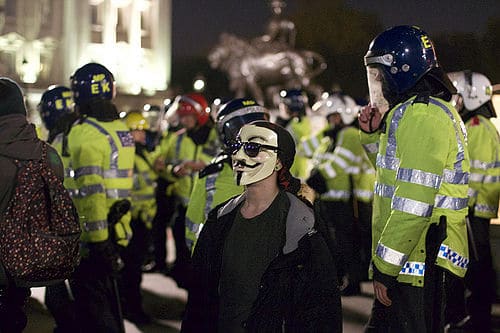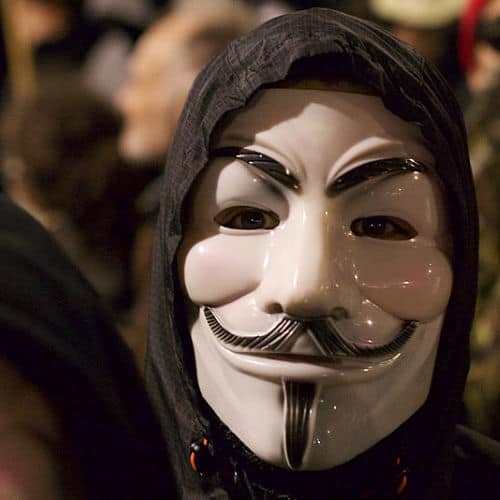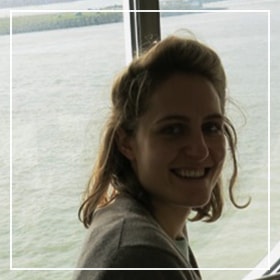People have been trickling into the top of Trafalgar Square since noon. By five darkness has launched its steady discolouration of the world and there must be over a thousand. By six the moon is visible and the number has trebled. Every minute more pour in. Green lasers dance across the facade of the National Gallery amidst an orchestra of whistles and horns. ‘Occupy the square! Occupy the square!’ The first authorless chant of the night brings bodies down to Nelson’s Column, which becomes the natural axis around which this gathering of civic anger grows. Some clamber onto the base to hold banners, to be seen; and fireworks start soaring skywards from the crowd beneath, reaching their crimson climax to bellyful cheers. It’s bonfire night in London, 5th November 2014. A centuries-old British tradition is being invented anew by Anonymous. Now we call it the Million Mask March.
Political pain is popular now. Denizens of a variety of ages and backgrounds are here in large numbers. There are teenagers who’ve brought their parents along. Parents who’ve brought their kids along. Pensioners. Disabled. Students. Ex-servicemen. Some are unemployed and others employed half-heartedly. Many work as carers and just can’t believe their eyes. Judith Butler was right about assemblages like these (2013): conditions are becoming unliveable and people have come from all corners of the country to pronounce it.
Eight thousand souls sighing the same sentence, ‘We are here and we’re struggling’.
‘We are here’ is enough, because the great private joke is that this isn’t a march. Indeed Anonymous as a phenomenon of streets and squares is partly borne out of white-knuckled frustration with those marches of the Old Left that go from ‘point A to point B’. Let’s not forget that point A to point B is a telos, that it assumes the inexorability of progress should enough people shuffle along. ‘Anons’ assume no such thing—2003 was the last of those thank you. That kind of faith in the convergence of time, history, and the good is old news now. Look at where it’s gotten us.
So ‘instead of going from A to B, you go A, B, D, E, J’.
The Million Mask March isn’t a march; it’s a sequence of symbolic visits.
And instead of a pre-ordained route, we are carried along by a number of instructive chants which seem to bubble up from nowhere. The second of these takes us down to Parliament. ‘Let’s march!’ (bang bang—a set of drums rattle in agreement). ‘Let’s march!’ (bang bang). Forty-five minutes later there’s a solo cry of ‘To the Palace!’ and before long we’re outside it: lasers playing on the stucco and fireworks screaming all over the place. Something happens here. Something about the open space around the Victoria Memorial, and the potency this egalitarian crew draw from desecrating the house of hereditary hierarchy. Because when the black bloc cut through our midst like a finger through sand yelling ‘Oxford Street! Oxford Street!’ there’s a qualitative shift. It’s a self-confident crowd that strides through Green Park. On surfacing into the wide street of Piccadilly Anons take full ownership, spreading out, high-fiving lorry and taxi drivers as they do. ‘Join us people of Britain!’ they offer. At this racing pace it doesn’t take long for us to pass over Oxford Street, towards the more symbolically charged site around Broadcasting House. When the vanguard gets near it the stride becomes a sprint, but the police soon clock onto what’s happening and beat them to the doors.
Like a river re-routed by a fallen rock, the stream of people just behind them instinctively swim right around the side, then curl left towards the building’s back.
There are more windows here, and we meet a man sitting at his desk just a metre away. People thunder on the glass with their fists, fury at the BBC’s coverage of austerity and other scandals making immediate contact with its outer shell. Yet he puts on a remarkable display of not seeing or hearing, a faint smile playing on his lips. ‘Establishment bastard’ someone near me says, in a throaty voice of genuine disgust. After that the parade continues for many miles, but in a profound way it has ended there. The main reason to keep moving after that is strategic. It’s the only way to avoid kettling.
Because although this is a wildly libertarian event, Facebook informs us of one strict rule: ‘total non-compliance’. Back in Trafalgar Square when the police attempt to disperse a few leaflets, several fiery females—masks embroidered with lace and made up with paint—remind everyone of this through a megaphone. ‘Do not talk to the police. Do not talk to the police. You are engaging with them!’ Despite the lack of encouragement the police persist with their Panglossian approach, communicating to no one in particular the letter of the law. An LED dot-matrix is put to negligible effect at the mouth of Whitehall.
‘Metropolitan Police Notice: Please beware of the following,
No fires are allowed or setting off of fireworks
No amplified music no graffiti
No climbing on buildings or monuments
No activities that cause serious disruption to other people
We thank you for your co-operation’.
Anons obediently interpret these as a list of do’s.
Yet non-compliance has a broader resonance with Anons than just eluding police ‘like cat and mouse’. It’s also an annual opportunity to explore non-compliance to a whole range of sartorial and semantic norms. A surprising number turn up in capes and gowns: invoking ‘V’ of the eponymous film. Others take the gown as a starting point and run. A young man from a northern mining family appears in robes of white as Jesus Christ. His fidelity to the role is quite something. ‘Jesus our saviour!’ a group of girls cry excitedly when he steps through the throng outside Parliament. He tilts his head back and raises one arm aloft, to be photographed in a gesture of celestial grace. Conscious or not the interocularity is vivid. He channels a thousand half-remembered religious paintings in that instant. But of course it’s a joke. The whole thing is a joke. And when several of my friends arrive in their smartest suits and ties that’s a joke too—but of a more elaborate kind. They say these norms are a joke. Look at where they’ve gotten us.

The point of being present then, is not to do one thing but to question another. When Occupy London refuses to sanction the event on the grounds that ‘It’s not a protest’ in a way they’re right. It’s not a protest but rather an appearance. In fact the French word for protest suits us far better here: manifestation. But it is an appearance which queries the very nature of appearances: one which subverts signification of the flag, the suit, even the political sign. Indeed there’s a whole genre of scribbled messages which mock the linearity of the message itself. In its stead interpretation folds inwards, words becoming edges of some intricate origami. ‘Has Pudsey had a CRB check?’ one sign inquires politely. On one level it’s a jolly good question.
Since Antonin Artaud theatricians have been thinking about the concept of the double. The double is the dual character of performance. It is the idea that on the one hand, performance needs an actor, whose body functions as the principal vehicle for its realisation. Yet on the other hand it needs something more than this: what the actor does operates within a world of representation within which it can assume meaning. Profoundly influenced by Freud, for Artaud this dual character was a pathway to the unconscious. Artaudian performance then sought to rattle all those inner cages, to rouse the ‘heart’s memory’ (1958: 134) of an audience. As Allain and Harvie say of his approach, ‘Theatre should recall those moments when we wake from dreams unsure whether the dream’s content or the bed we are lying in is our reality’ (2014: 18).
Interestingly Anons share the same discourse of consciousness, of ‘dreaming’ and of ‘waking up’. Except where Artaud’s double is predicated on ambivalence and uncertainty, Anons are resolute which side of reality they are on. They are wide awake.
Sophie Nield has developed a theatrical concept of the double with respect to Occupy (2015). When in 2011 thousands poured into public spaces, remaking these as sites of life—with folks there just eating, sleeping and meeting each other—Nield argues there was a complex dramaturgical game taking place. Through the process of performing private life in public, Occupy ‘translated itself into a representation of what it actually was’ (2015: 130). It doubled. Occupiers assumed the dual character of performance, functioning as both bodies and representations thereof.
It is no coincidence that Anonymous in the UK, in its physical incarnation, was forged in the fires of Occupy. Having appeared online for several years it emerged at the camp fully formed, ideas enfleshing themselves. Thus in this coupling of appearance with embodiment they too doubled up, they too said—and say still—’we are here’. Yet there has always been a crucial difference. Because while Occupy doubled as what they ‘actually’ were, never relinquishing identity, Anons double as what they are emphatically not. That is their grandest joke of all.
They say we are not these masks. We are not these suited professionals. We are certainly not Jesus. In doing this, they become something else.
References
Artaud, Antonin. 1958. Theatre and its Double. New York: Grove Press.
Allain, Paul, and Jen Harvie. 2014. The Routledge Companion to Theatre and Performance. Second Edition. Routledge Companions. London ; New York: Routledge.
Butler, Judith, and Athena Athanasiou. 2013. Dispossession: The Performative in the Political. Cambridge: Polity Press.
Nield, Sophie. 2015. “Tahrir Square, EC4M: The Occupy Movement and the Dramaturgy of Public Order.” In The Grammar of Politics and Performance, edited by Shirin M. Rai and Janelle Reinelt, 121–33. Routledge.
**************
Featured image by bjpcorp (flickr, CC BY 2.0)






Excellent article and I very much enjoyed reading it. I do however think you ascribe too much to the Anons. Your last paragraph is key in my view. They are the latest manifestation or mutation, depending on one’s leanings, of the protests movements of the loony left – a coming together of the professional protestors, rent a mob types and unemployed who have now – thanks Mr corbyn’s election victory – become even more empowered. It will be interesting to see how things play out with a resurgent left-wing (mainstream) alternative. Thanks again for the great read!
Bravo Vita! A stirring and thought provoking article. As a former Anonymous activist I applaud your insight.